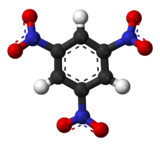1,3,5-Trinitrobenzene
 |
|
 |
|
| Names | |
|---|---|
|
IUPAC name
1,3,5-Trinitrobenzene
|
|
| Other names
sym-Trinitrobenzene
|
|
| Identifiers | |
|
3D model (JSmol)
|
|
| ChemSpider | |
| ECHA InfoCard | 100.002.502 |
|
PubChem CID
|
|
| UN number | 0388 |
|
|
| Properties | |
| C6H3N3O6 | |
| Molar mass | 213.11 g·mol−1 |
| Density | 1.76 g/cm3 |
| Melting point | 123.2 °C (253.8 °F; 396.3 K) |
| Boiling point | 315 °C (599 °F; 588 K) |
| 330 mg/L | |
| -74.55·10−6 cm3/mol | |
| Hazards | |
| NFPA 704 | |
|
Except where otherwise noted, data are given for materials in their standard state (at 25 °C [77 °F], 100 kPa).
|
|
|
|
|
| Infobox references | |
1,3,5-Trinitrobenzene is a nitrated benzene-derivative that is classified as a high explosive, being moderately explosive in liquid form and extremely explosive in its dry powder form. It has a clear to light yellow sludgy appearance. It will detonate under strong shock. High temperatures, whether by sudden heating of any quantity, or by the accumulation of heat when large quantities are burning, will also cause detonation. The material can react vigorously with reducing materials and is incompatible with sodium dichromate or sulfuric acid. It must be stored in a cool, ventilated place, away from acute fire hazards and easily oxidized materials. It also reacts violently with aluminium, boron phosphide, cyanides, esters, PN2H, phosphorus, NaCN, SnC12, sodium hypophosphite, thiocyanates, etc. When heated to decomposition it emits highly toxic fumes of NOx. It is an extremely powerful oxidizing agent which may cause violent reaction with reducing materials.
Trinitrobenzene is used primarily as a high explosive for commercial mining and military use. Some other uses include a narrow-range pH indicator, an agent to vulcanize natural rubber, and a mediating agent to mediate the synthesis of other explosive compounds.
It is recommended that people avoid contact if possible. Avoid breathing dusts, and fumes from burning or reacting material. Wear appropriate chemical protective gloves and goggles. Do not handle broken packages unless wearing appropriate personal protective equipment. Wash away any material which may have contacted the body with copious amounts of water or soap and water. Do not store near other chemicals (especially other oxidizers), near sources of heating, or places where rapid temperature changes may occur. In case of spillage immediately soak with water and carefully and slowly clean up. In case of fire let burn; DO NOT attempt to put out the resulting fire. In any case where the compound is ingested call Poison Control Center immediately.
...
Wikipedia

